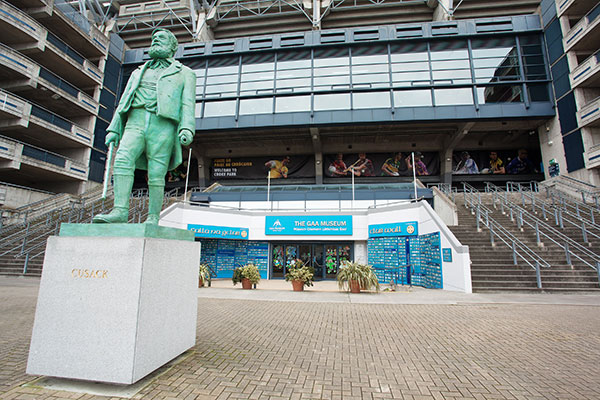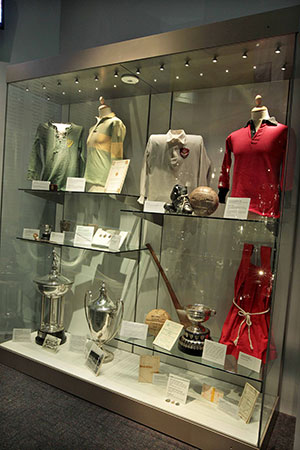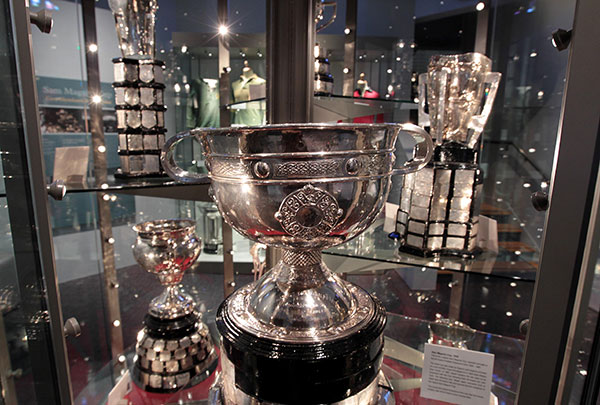GAA Museum
Published in Issue 6 (November/December 2018), Reviews, Volume 26Croke Park
crokepark.ie/gaa-museum-tours/gaa-museum
By Tony Canavan

Above: The entrance to the museum under the Cusack Stand is impressive, as you have to pass a statue of Michael Cusack himself.
This year sees the twentieth anniversary of the opening of the Gaelic Athletic Association Museum in Croke Park. The entrance to the museum in the Cusack Stand is impressive, as you have to pass a statue of Michael Cusack himself. If you did not already know, the museum soon explains that Cusack was the driving force behind the establishment of the GAA in 1884.
At first sight it may seem too commercially orientated, as you pass through a gift shop to get to the exhibitions, but any such notion is soon dispelled once you become immersed in the museum itself. Our indigenous games are ancient indeed—the earliest documentary evidence for hurling dates from the eighth century—and consist of more than hurling, football and camogie, as handball, rounders and other sports originally fell under the aegis of the GAA. There are handsets through which you can hear dramatised accounts of descriptions of Gaelic sports by visitors to Ireland in the seventeenth and eighteenth centuries. Such activities were not always civilised before formal rules were introduced in the nineteenth century.
The museum is conventional in layout, with display cabinets, information panels and videos. The original artefacts, such as a turnstile, old hurley or club banner, grab your attention immediately. The museum is self-guided, although tours of it and the stadium are on offer. It must be admitted that some of the panels can be wordy in their endeavour to give a comprehensive account of the history, but those who do not have the patience to read these will find information supplied in a more palatable format in the many videos that run throughout. Indeed, I was struck right away by the sounds in the museum: voice-overs in documentaries, commentaries on famous matches and the cheering of fans. Elsewhere such a cacophony might be distracting, but here it seems to embody the vibrancy of the GAA and its sports.
The main exhibition area begins by setting the international scene for the foundation of the GAA. The regulation of sports in Europe and America was soon followed by the establishment of associations to ensure that rules were followed and to organise competitions. Ireland was not far behind these developments, particularly in relation to England, to which the Association may be seen as a reaction. From small beginnings in Thurles, the GAA became the dominant sporting organisation in Ireland, and from its earliest days had connections with the diaspora.
Alongside the sporting story is one of politics and society. From the beginning, the GAA was intertwined with politics and national identity. The story of the GAA is almost the story of modern Ireland, as is reflected in the sections that deal with the War of Independence and the Civil War. The GAA was seen as a rallying point for Irish patriots and as such the association and its members came in for unwanted attention from the Crown forces. The infamous events of Bloody Sunday (21 November 1920) were just an extreme example of how the GAA suffered.

Above: There are medals and cups, jerseys, hurleys, whistles, stopwatches, champions’ belts and much more besides that give an insight into the GAA in its early days.

Above: The Sam Maguire and Liam McCarthy Cups (behind, to the right).
Check out the Hall of Fame, with its hurling and football teams of the millennium, and learn the story behind the famous trophies named after Sam Maguire and Liam McCarthy. There is a special exhibition celebrating twenty years of the museum, marking key events and big occasions that have taken place over the last two decades. When you drag yourself away from the artefacts and videos downstairs, you can go upstairs to see an area devoted to the modern GAA.
Here is a celebration of local clubs and significant players from across Ireland, including an oral history project that has recordings of ordinary people discussing what the GAA means to them. The GAA encompasses both the generations, finding a place for people of all ages and abilities, and the counties, as almost every parish on the island has a GAA club.
If this all sounds very worthy, you can end your visit with a bit of fun. A number of interactive displays give you the chance to test yourself and your skills—reaction times and knee bends, jumping and catching the ball. After all that running, kicking and hurling, you’ll probably be ready for some refreshment in the museum’s café.
Tony Canavan is editor of Books Ireland.
















